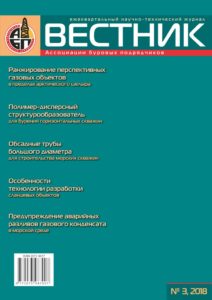SIMULATION OF IMPACT OF GAS EXPLOSIONS ON STRUCTURES OF OFFSHORE PLATFORMS TO CALCULATE THEIR SURVIVABILITY
Kharchenko Yu.A. – Doctor of Technical Sciences, Professor of the Gubkin Russian State University of Oil and Gas (National Research University), doc.2004.8@yandex.ru doc.2004.8@yandex.ru
Gritsenko A.I. – Doctor of Technical Sciences, Professor, Corresponding Member of the Russian Academy of Sciences, Advisor to the General Director of Gazprom VNIIGAZ LLC, doc.2004.8@yandex.ru doc.2004.8@yandex.ru
Atayan G.E. – Deputy Director General, Gazprom Gazobezopasnost LLC, Grigory.age@gmail.com Grigory.age@gmail.com
Artemyev N.A. – graduate student, Gubkin Russian State University of Oil and Gas (National Research University), talaken@mail.ru talaken@mail.ru
УДК 629.5.02+004.942+544.454
Key words: gas explosion, gas cloud, numerical simulation, pressure, temperature, offshore structure, endurance criterion, accidents, AutoReaGas, FLACS.
Oil and gas platforms should provide the safest conditions for personnel work and the ability to promptly conduct emergency rescue operations in cases of emergencies associated with gas explosions. Therefore, it is necessary to take into account the possibility of occurrence and development of such an emergency in calculating the endurance criterion of platforms. The article deals with the numerical simulation of a gas explosion for calculating the endurance criterion of the oil and gas platform. Commercial software products for simulation of gas explosions used in domestic practice are shown. The main stages of the explosion modeling process are identified. An example of a geometric model of an oil and gas platform executed in the AutoReaGas software is presented. A scenario of an explosion with a flammable gas leak in the FLACS program is also shown. The need to consider several scenarios of the explosion is justified. As a result, the most accurate approach to probabilistic estimation is determined, based on the modeling of as many scenarios as possible and their gradation by severity of impact and probability of occurrence.
SIMULATION OF IMPACT OF GAS EXPLOSIONS ON STRUCTURES OF OFFSHORE PLATFORMS TO CALCULATE THEIR SURVIVABILITY
Kharchenko Yu.A. – Doctor of Technical Sciences, Professor, Gubkin Russian State University of Oil and Gas (National Research University), doc.2004.8@yandex.ru
Gritsenko A.I. – Doctor of Technical Sciences, Professor, Corresponding Member of the Russian Academy of Sciences, Advisor to General Director of Gazprom VNIIGAZ LLC, doc.2004.8@yandex.ru
Atayan G.E. – Deputy Director General, Gazprom Gazobezopasnost LLC, Grigory.age@gmail.com
Artemyev N.A. – graduate student, Gubkin Russian State University of Oil and Gas (National Research University), talaken@mail.ru
Key words: gas explosion, gas cloud, numerical simulation, pressure, temperature, offshore structure, endurance criterion, accidents, AutoReaGas, FLACS.
Oil and gas platforms should provide the safest conditions for personnel work and the ability to promptly conduct emergency rescue operations in cases of emergencies associated with gas explosions. Therefore, it is necessary to take into account the possibility of occurrence and development of such an emergency in calculating the endurance criterion of platforms. The article deals with the numerical simulation of a gas explosion for calculating the endurance criterion of the oil and gas platform. Commercial software products for simulation of gas explosions used in domestic practice are shown. The main stages of the explosion modeling process are identified. An example of a geometric model of an oil and gas platform executed in the AutoReaGas software is presented. A scenario of an explosion with a flammable gas leak in the FLACS program is also shown. The need to consider several scenarios of the explosion is justified. As a result, the most accurate approach to probabilistic estimation is determined, based on the modeling of as many scenarios as possible and their gradation by severity of impact and probability of occurrence.


